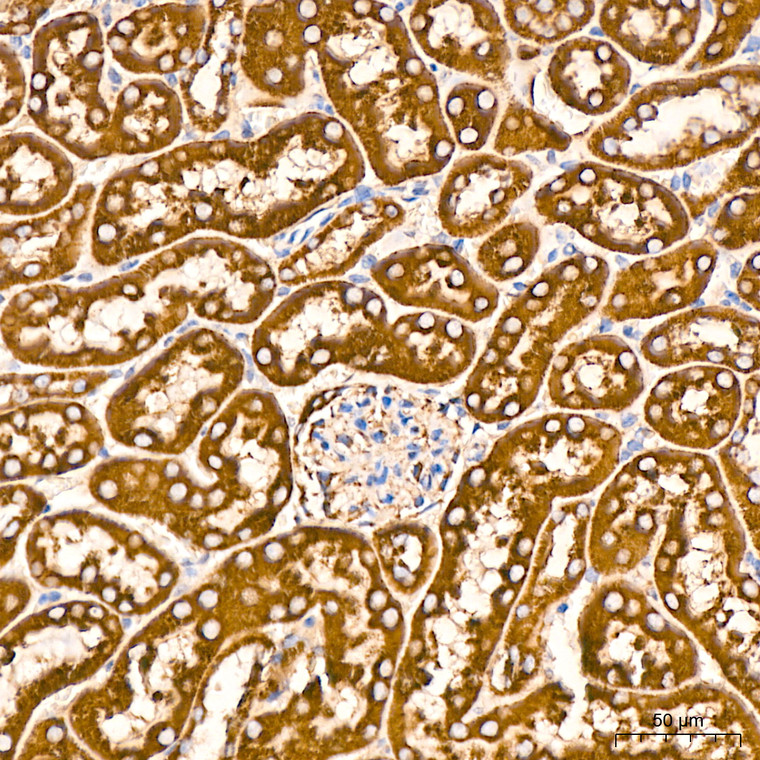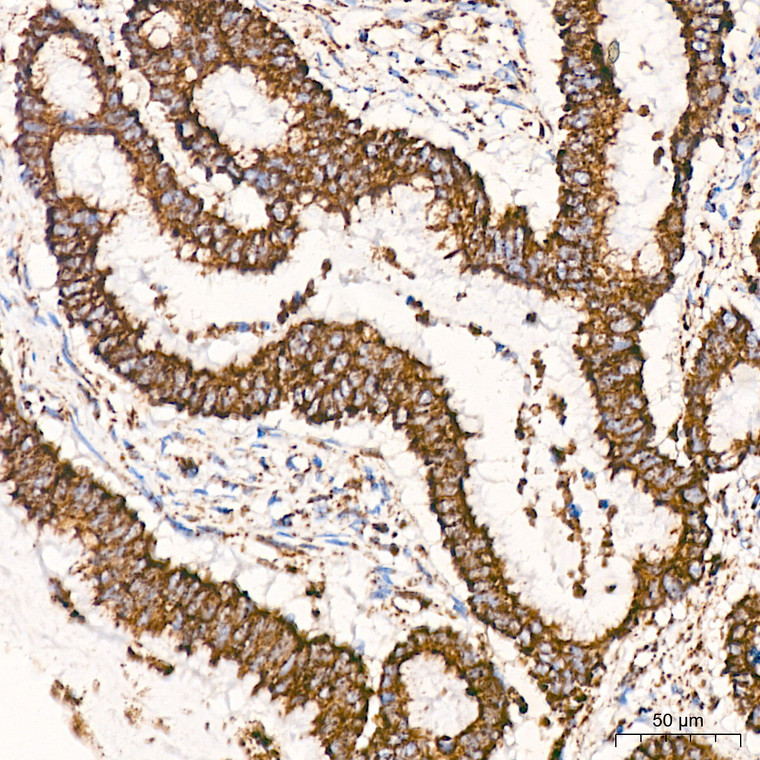| Host: |
Rabbit |
| Applications: |
WB/IHC/IF |
| Reactivity: |
Human/Mouse/Rat |
| Note: |
STRICTLY FOR FURTHER SCIENTIFIC RESEARCH USE ONLY (RUO). MUST NOT TO BE USED IN DIAGNOSTIC OR THERAPEUTIC APPLICATIONS. |
| Short Description: |
Rabbit monoclonal antibody anti-VDAC1 (1-100) is suitable for use in Western Blot, Immunohistochemistry and Immunofluorescence research applications. |
| Clonality: |
Monoclonal |
| Clone ID: |
S7MR |
| Conjugation: |
Unconjugated |
| Isotype: |
IgG |
| Formulation: |
PBS with 0.02% Sodium Azide, 0.05% BSA, 50% Glycerol, pH7.3. |
| Purification: |
Affinity purification |
| Dilution Range: |
WB 1:500-1:2000IHC-P 1:50-1:200IF/ICC 1:50-1:200 |
| Storage Instruction: |
Store at-20°C for up to 1 year from the date of receipt, and avoid repeat freeze-thaw cycles. |
| Gene Symbol: |
VDAC1 |
| Gene ID: |
7416 |
| Uniprot ID: |
VDAC1_HUMAN |
| Immunogen Region: |
1-100 |
| Immunogen: |
A synthetic peptide corresponding to a sequence within amino acids 1-100 of human VDAC1 (P21796). |
| Immunogen Sequence: |
MAVPPTYADLGKSARDVFTK GYGFGLIKLDLKTKSENGLE FTSSGSANTETTKVTGSLET KYRWTEYGLTFTEKWNTDNT LGTEITVEDQLARGLKLTFD |
| Tissue Specificity | Expressed in erythrocytes (at protein level). Expressed in heart, liver and skeletal muscle. |
| Post Translational Modifications | Phosphorylation at Ser-193 by NEK1 promotes the open conformational state preventing excessive mitochondrial membrane permeability and subsequent apoptotic cell death after injury. Phosphorylation by the AKT-GSK3B axis stabilizes the protein probably by preventing ubiquitin-mediated proteasomal degradation. Ubiquitinated. Undergoes monoubiquitination and polyubiquitination by PRKN.monoubiquitination at Lys-274 inhibits apoptosis, whereas polyubiquitination leads to its degradation and promotes mitophagy. Deubiquitinated by USP30. |
| Function | Forms a channel through the mitochondrial outer membrane and also the plasma membrane. The channel at the outer mitochondrial membrane allows diffusion of small hydrophilic molecules.in the plasma membrane it is involved in cell volume regulation and apoptosis. It adopts an open conformation at low or zero membrane potential and a closed conformation at potentials above 30-40 mV. The open state has a weak anion selectivity whereas the closed state is cation-selective. Binds various signaling molecules, including the sphingolipid ceramide, the phospholipid phosphatidylcholine, and the sterol cholesterol. In depolarized mitochondria, acts downstream of PRKN and PINK1 to promote mitophagy or prevent apoptosis.polyubiquitination by PRKN promotes mitophagy, while monoubiquitination by PRKN decreases mitochondrial calcium influx which ultimately inhibits apoptosis. May participate in the formation of the permeability transition pore complex (PTPC) responsible for the release of mitochondrial products that triggers apoptosis. May mediate ATP export from cells. |
| Protein Name | Voltage-Dependent Anion-Selective Channel Protein 1Vdac-1Hvdac1Outer Mitochondrial Membrane Protein Porin 1Plasmalemmal PorinPorin 31hlPorin 31hm |
| Database Links | Reactome: R-HSA-1268020Reactome: R-HSA-5205685Reactome: R-HSA-5689880Reactome: R-HSA-70268Reactome: R-HSA-8949215 |
| Cellular Localisation | Mitochondrion Outer MembraneMulti-Pass Membrane ProteinCell MembraneMembrane Raft |
| Alternative Antibody Names | Anti-Voltage-Dependent Anion-Selective Channel Protein 1 antibodyAnti-Vdac-1 antibodyAnti-Hvdac1 antibodyAnti-Outer Mitochondrial Membrane Protein Porin 1 antibodyAnti-Plasmalemmal Porin antibodyAnti-Porin 31hl antibodyAnti-Porin 31hm antibodyAnti-VDAC1 antibodyAnti-VDAC antibody |
Information sourced from Uniprot.org
12 months for antibodies. 6 months for ELISA Kits. Please see website T&Cs for further guidance













